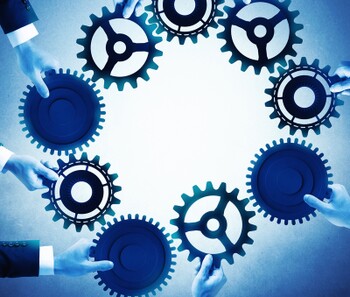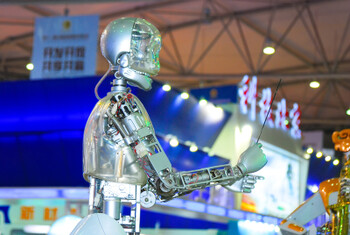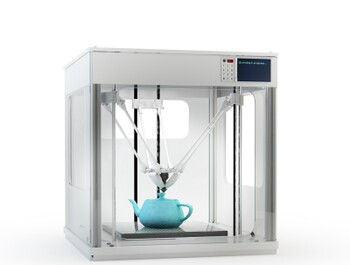Will the fifth industrial revolution save the world?
2016-04-25
 The topic of the fourth industrial revolution is on the agenda more and more often. It appears almost every day in the media, but industrial companies are addressing it too. Some of them already show the introduction of autonomous self-regulation of production lines, which is possible due to the fact that the individual production machines communicate with each other.
The topic of the fourth industrial revolution is on the agenda more and more often. It appears almost every day in the media, but industrial companies are addressing it too. Some of them already show the introduction of autonomous self-regulation of production lines, which is possible due to the fact that the individual production machines communicate with each other.
This innovation does not consist of complementing other controllers, but in interconnecting them so that everything in the company can communicate and provide intelligent support for workers.
But can we say with certainty today what awaits us after the fourth industrial revolution? Already initiatives and challenges are arising to indicate further development. We encountered them are the technology.future 2016 conference, the mission of which was to show that what was a dream not long ago is now a reality. Here are the main topics that resonated at the conference.
Hands-free control in industrial environments
This topic could be interesting especially for manufacturing companies, where in handling sensitive components any additional equipment nearby is a potential risk of damage to components or tools.
 These companies often face the question: “How to record the performance of a production task or its result in our specific environment?”
These companies often face the question: “How to record the performance of a production task or its result in our specific environment?”
The company ANASOFT presented the MES/MOM EMANS production system, which is part of the non-traditional solution to this situation – hands free control. EMANS uses Kinect from Microsoft for detecting movement of workers in production. Kinect is a device capable of using advanced infrared cameras and sensors to track body movements, recognize facial expressions or hand gestures.
As part of this solution, Kinect detects a predefined gesture remotely, i.e. without the worker having to go to the monitor and touch something. This not only eliminates the risk of product damage but increases productivity, and also because the company obtains further information, it has a better overview of production and arranges traceability - the manufacturing history of each component.
This exceptional integration of object recognition technology, communications, human-machine also in a version without touch-screens, has other potential uses however. In addition to confirmation of the end of the assembly process with a gesture, it can be used to confirm the results of inspection and the analysis of movement of workers to optimize ergonomics in the workplace.
3D simulation and virtualization of the production company
Another interesting topic was the virtual simulation of the future production plant. Using 3D simulation provides the ability to model the production environment and simulate the consequences of different decisions. The result is a greater degree of confidence that the solution proposed the right one for the organization - even before it proceeds to the implementation of changes.
 This is enabled by technology with the ability to visualize designs of entire production systems in detail, including the position of parts in relation to the shape of the machine and watch for possible collisions.
This is enabled by technology with the ability to visualize designs of entire production systems in detail, including the position of parts in relation to the shape of the machine and watch for possible collisions.
With a single click, simulation tools can create complete a 3D model based on the original 2D design layout. This provides a more immersive visualization, particularly using a modern 3D interface display.
Another innovation that has been introduced in this area is the use of virtual reality goggles. After putting them on, one can walk through the works and see how things could look and function. This idea was introduced by Cognis VR and they have progressed it even further. They have created a learning platform, which is based on the use of virtual reality. With it, students should be able to learn through their own experiences, making them more able to engage and offering them a greater degree of understanding than that of a standard explanation by the teacher. Through partial automation of education, teachers would get more space for a personal approach to students.
3D printing with non-traditional materials
Let us stay with the topic of 3D. We were interested in the idea of 3D printing using metal as a material. Metal parts are printed using a technology whereby the metal powder is applied layer by layer and joined by local melting, which is achieved by laser beam.
This is not only for prototyping, but the efficiency of this technology can also be used in mass production. It can be applied for example for such components whose desired shape would be technologically demanding to produce. When printing with a 3D printer, such a component can be printed as a single unit without the need for difficult bonding of sub-components.
Waste-free production – INDUSTRY 5.0?
The concept of recycling is now widely used and it is understood to include recovering materials that have already been used for a purpose and that have become waste. The resulting materials are used mostly either alone or in admixture for the manufacture of products from primary raw materials, in order to reduce production costs and, in some cases, to improve the properties of the product itself.
IBCSD Lab, however, presented a new perspective on how to deal with waste in production. Waste in production is perceived as remaining raw material, which can be used differently. Such waste or remainder from industrial production doesn’t usually need to be sorted or decontaminated. Therefore, its subsequent use is much easier and it can be used directly, for example, by its producer. Recovery of the remainder is therefore performed on the level of use of the basic raw material.
For better understanding we state the example which IBCSD Lab presented. In a manufacturing business, components they are delivered by suppliers in polystyrene containers. The company disposes of this packaging as waste. However, the company itself dispatches its own end products dispatched polystyrene packaging. As part of the reduction of waste they decided not to throw “polystyrene waste” away at first sight, and they began to take packaging to their suppliers to be transformed into the desired shape for packaging the finished products.
Such recovery of unused material from production leads to waste-free production. It's certainly the direction companies should choose in the future to maintain a better balance on earth. It is therefore fully appropriate to call it the fifth industrial revolution.
You might also be interested in
- Industry 4.0 the Main Topic at the Davos World Economic Forum
- Jump on the Wave of the Fourth Industrial Revolution Today
- The Fourth Industrial Revolution Has Already Begun








